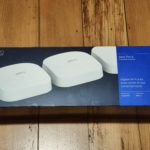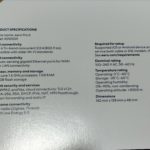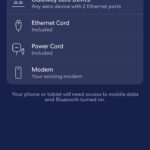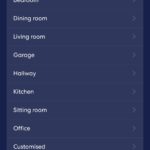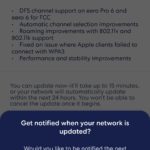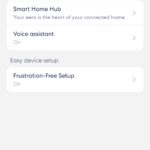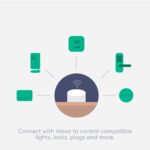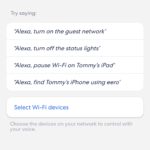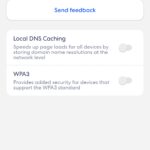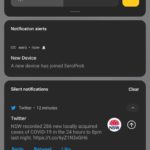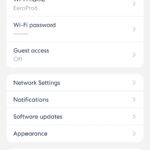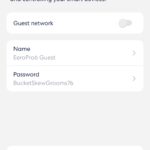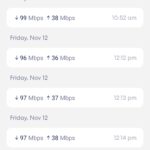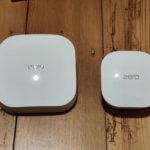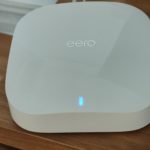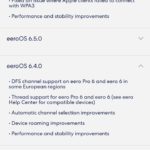Amazon’s Wi-Fi division eero has been selling their new top model eero Pro 6 in Australia for a few weeks now and I’ve been testing it out in my house in real life as our Wi-Fi network.
Compared to their base model eero 6 model, each eero Pro 6 node has:
- Double the RAM
- A faster CPU
- 2 gigabit LAN ports
- A 3rd Wi-Fi band to reduce congestion and enable more simultaneous devices (over 75 across the system)
Both models support Apple Homekit and have Zigbee hubs in each eero node.
The eero Pro 6 is backward compatible with all eero generations, making it easy to expand your network or mix and match eero devices to create a custom system. However if you want your mixed eero model system to be all Wi-Fi 6 you can only use eero Pro 6 and eero 6 nodes together.
Specifications
- Wi-Fi connectivity – Tri-band wifi radios, simultaneous 2.4 GHz & 5 GHz Lo & 5 GHz Hi; 2×2/2×2/4×4 MU/SU-MIMO; WMM, Tx Beamforming, OFDMA; Wi-Fi 6 (IEEE802.11a/b/g/n/ac/ax)
- Wired connectivity – Dual auto-sensing gigabit ports for WAN and/or LAN connectivity
- Smart home connectivity – Zigbee Smart Home Hub, Works with Alexa, Amazon Frustration-Free setup, Bluetooth Low Energy 5.0
- Processor, memory, and storage – 1.4 GHz quad-core processor, 1024MB RAM, 4GB flash storage
- Security and network services – WPA2-AES, WPA3-Personal transition mode, Parental Controls
- Required for setup – Supported iOS or Android device, internet service (with NBN or 4G/5G modem if your ISP requires PPPoE like iiNet)
- Operating Requirements – 0°C to 40°C (32°F to 104°F); Electrical: 100-240V AC, 50-60 Hz; Power supply: 27W external
- Dimensions: 139 x 139 x 52.6 mm
Setup
Inside the box you’ll find three eero Pro 6 nodes, three 27 watt power packs that connect to the nodes via USB-C, a single ethernet cable and a set of quick start instructions.
NB. If your ISP is like iiNet and requires PPPoE then you have to use the eero connected to your iiNet modem, with eero in bridge mode or double NAT’d.

The simplicity of setup is one of the key features of eero taking just minutes using the in-app instructions. Once your new eero Pro 6 is up and running, you can also connect your compatible Amazon smart home devices to your Wi-Fi network in fewer steps.
Since all three eero Pro 6 nodes are identical it doesn’t matter which one you setup first. After you’ve setup the 1st one, you follow the same process for the others.
Placement is very important and eero setup will guide you to make sure the signal strength between each eero node is strong. Cleverly they made the top of each eero node curved so people can’t place things on top of them.
After linking your eero account with your Amazon account, selected devices purchased with your Amazon account join the network straight away and stay connected when you change your network name or password. You’re highly like to get a systems update once connected to the Internet and every time there’s an eero update a clear change log is available.
Once you’re up and running all features and control of your network are app based including the ability to pause the internet, share your network with friends or guests, and more. Here are screenshots of the eero app without eero Secure or eero Secure+ enabled.
What it’s good at
One of my friends asked me a few weeks ago which mesh Wi-Fi system I recommended for their non technical neighbour and I said eero. That neighbour bought an eero system and managed to set it up without needing any help. It’s that easy.
For context my federation era home is a nightmare for Wi-Fi systems because all the walls interior and exterior are solid old double brick. It’s a 3 bedroom rectangle about 5m wide, 22m long, with a walkway on the side and gardens at the front and back. So I was expecting the eero Pro 6 Wi-Fi coverage to be similar to the Wi-Fi 6 D-Link COVR-X1873 mesh internet system I’ve used for the last few months but I was wrong. It’s actually better!
Any Wi-Fi system that manages to cover my whole home with a strong signal gets a tick and that Wi-Fi system would be able to provide signal to a much bigger house with modern thin interior gyprock walls. When connected to each other via Wi-Fi the eero Pro 6 mesh nodes distributed our NBN 100/40 NBN connection with 5Ghz Wi-Fi and 2.4Ghz Wi-Fi coverage to all of our home interior and into the garden.
Progressing to the 3 mesh nodes connected to each other via ethernet cable, there was little internet access performance difference as NBN access speed was still 100/40 throughout the house. I strongly recommended connecting all your mesh nodes via ethernet for NBN connections faster than 250/25 high end 5G home internet plans or if you have lots of internal walls.
Aesthetics are important in a home and eero designers understand that. Instead of traditional modem/router manufacturer designs with lots of blinking lights, angular shapes and sprouting antennas in all directions eero nodes are all white with soft rounded edges and one indicator light that can be turned off in the app or by voice.
As you can see the eero Pro 6 — left — is about as wide as a tissue box, it’s much bigger than the Wi-Fi 5 generation eero — right — but it’s still much smaller than a traditional modem/router.
If you have Echo speakers you can voice control some aspects of eero eg: “Alexa turn on the guest network” or “Alexa pause Wi-Fi on Timmy’s iPad”.
As you’d expect for their flagship Wi-Fi system the eero Pro 6 supports Wi-Fi 6 and has 3 wireless bands (2.4ghz 600 Mbps, 5ghz 1200 Mbps, 5Ghz 2400 Mbps). The two 5Ghz bands provide a big performance boost because all your 5Ghz Wi-Fi devices aren’t fighting for slices of a single data transfer pathway and the 3 eero nodes can transfer between each other with less congestion as well.
All eero devices use “TrueMesh” technology to intelligently route network traffic and help reduce congestion, buffering, and drop-offs so you can stream high resolution video , play games, and video conference with ease. Interestingly instead of using the 3rd Wi-Fi band just for traffic between nodes eero intelligently sends upload/download data from different devices whichever way is optimal at the time. If you connect your eero nodes up via ethernet cable then the intelligent traffic management uses that 4th data pathway as well.
eero says the built-in Zigbee smart home hub in each of the 3 eero Pro 6 nodes eliminates the need for additional Zigbee hubs. After you link your eero and Amazon account, Zigbee devices like smart lights, locks, plugs, and other compatible devices can be setup and connect directly to your eero network.
Each node also has support for Thread but at the moment I don’t have any new Zigbee or Thread devices to setup so we’ll have to accept these feature on trust.
eero is constantly working in the background to help keep your network safe and secure. Traditional routers sometimes require manual updates and even when they do support auto update there’s no guarantee for how many months or years this will work.
In comparison eero provides regular software updates with the latest security patches, bug fixes, and feature upgrades. These are guaranteed for at least 5 years from when that eero model was last available for purchase so with the eero Pro 6 you’ll get security and feature updates til at least 2026.
What you might not like
eero concentrates on making a wifi system that’s super simple to setup and uses constantly improving AI to optimise your performance. It’s an appliance for 95% of the population who want to setup their Wi-Fi system once and get good performance for several years. If you’re the 5% of people who wants lots of customisable router settings eero will frustrate you.
If your network has a number of Gigabit ethernet devices, there are only two Gigabit for each eero Pro 6 node. It would be handy if at least one eero 6 Pro node had 4 Gigabit ports since many people are likely to place their main eero node next to their TV/set top box/games console or NAS.
Default access to detailed Parental Controls, Content Filters and Dynamic DNS aren’t available. To get these features you to subscribe to eero Secure or eero Secure+. Perhaps eero Secure+ should be provided free for the first 3 months to let customers try it thoroughly and decide whether they want to pay for it afterwards; although that opens them up to user complaints of bait and switch.
Historical data usage – not all Wi-Fi systems provide this but the way eero does is annoying. Users get some information for the last week but not anytime previously unless you’ve got a subscription to eero Secure or eero Secure+.
No place like 192.168.0.1 – if you really really want a web based admin interface for your home Wi-Fi system then eero is not for you as the only admin interface is the eero app. This is the same as Google’s Nest Wi-Fi systems.
Should you buy it?
eero Pro 6 systems are available from www.amazon.com.au/eeroPro6 in addition to retailers including Officeworks and JB Hi-Fi. The 3 pack bundle we tested is currently on sale for $699 as part of the Black Friday sales with the normal RRP being $999.00
At the full RRP, I don’t think that the eero Pro 6 is worth the money. Amazon heavily discount their devices several times a year eg: Prime Day and during Black Friday Sales. At $699 to $799 eero Pro 6 is well worth it to give you set and forget Wi-Fi coverage throughout the house with guaranteed updates for at least 5 years.
The question then becomes: With the money you save would you accept the functionality or, pay for several years of eero Secure if you want to for $4.99/month (discounted to $49/year). If you’re after the full suite of functionality you’ll need to sign up to eero Secure+ for $15.99/month (discounted to 159.99/year) which provides the additional protection of three top-rated security apps: family licence 1Password for password management, 3 licences Malwarebytes for malware protection, and Encrypt.me VPN for all your devices.
At a discount on the RRP the eero Pro 6 is well worth your investment.
Disclosure Statement
Eero has allowed Ausdroid to use this Wi-Fi system long term to see how software updates impact on it's performance


